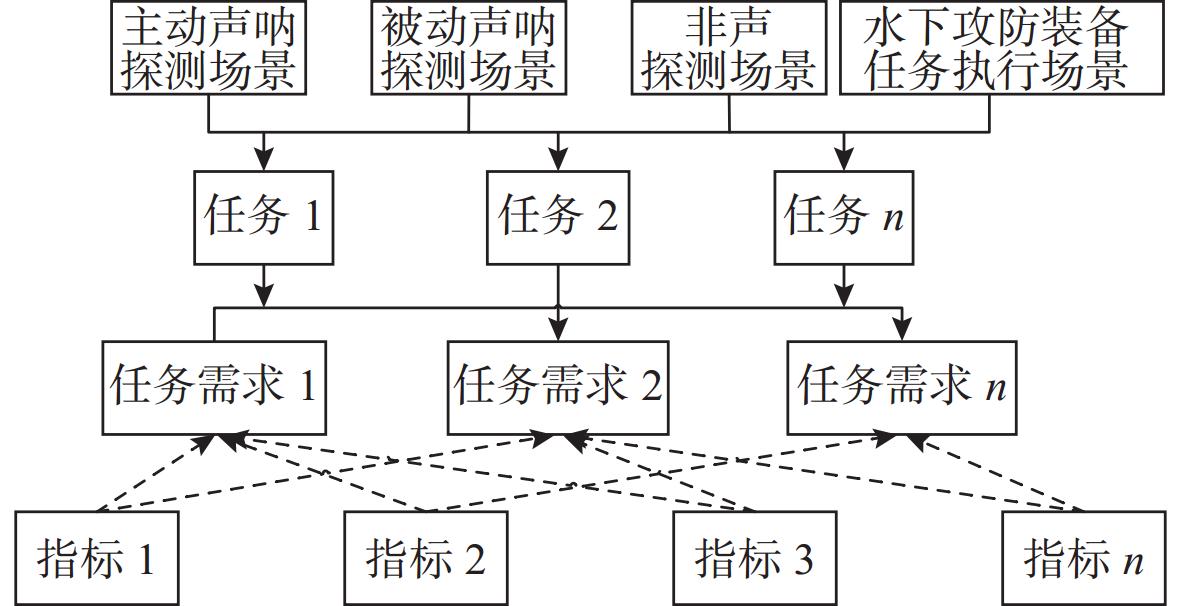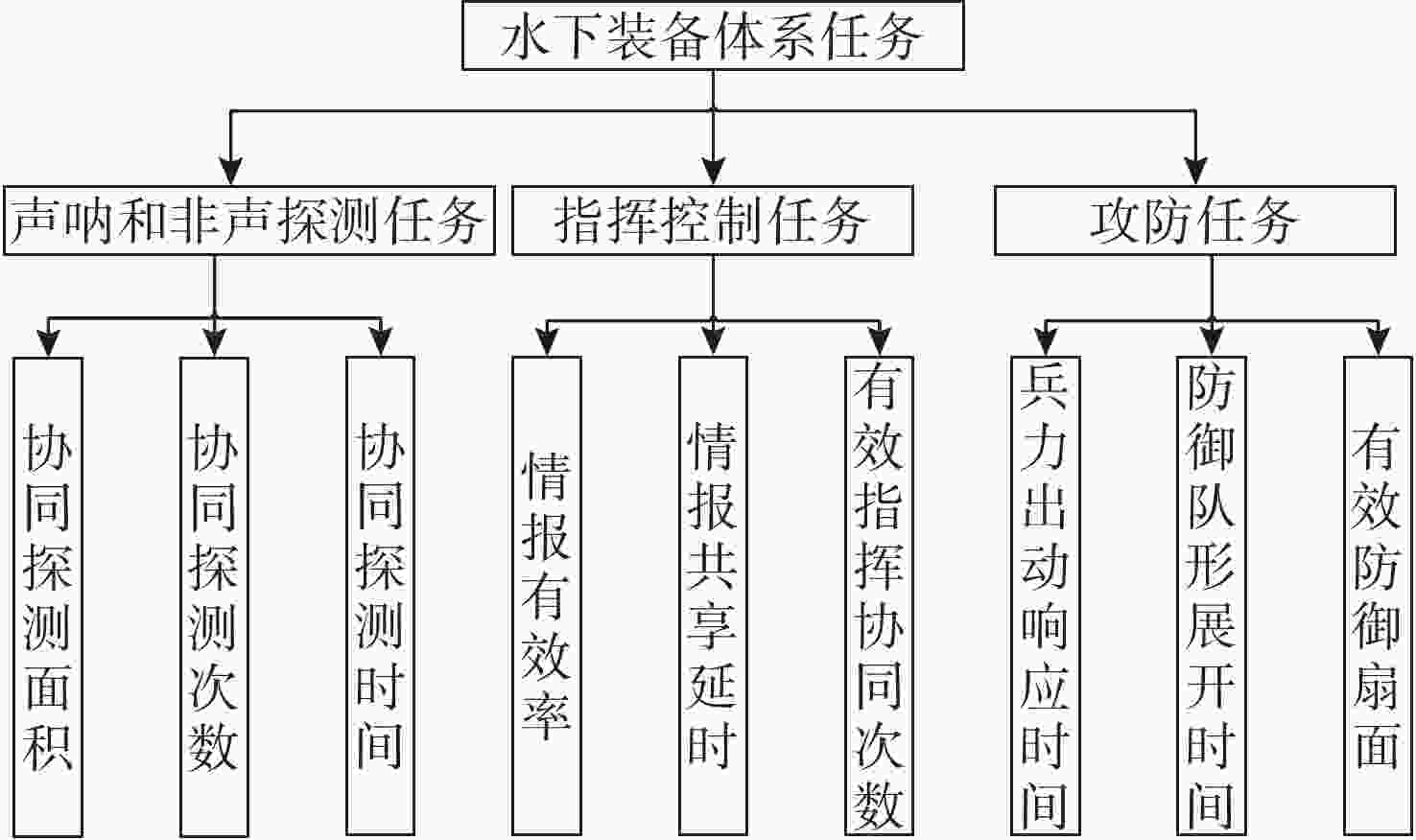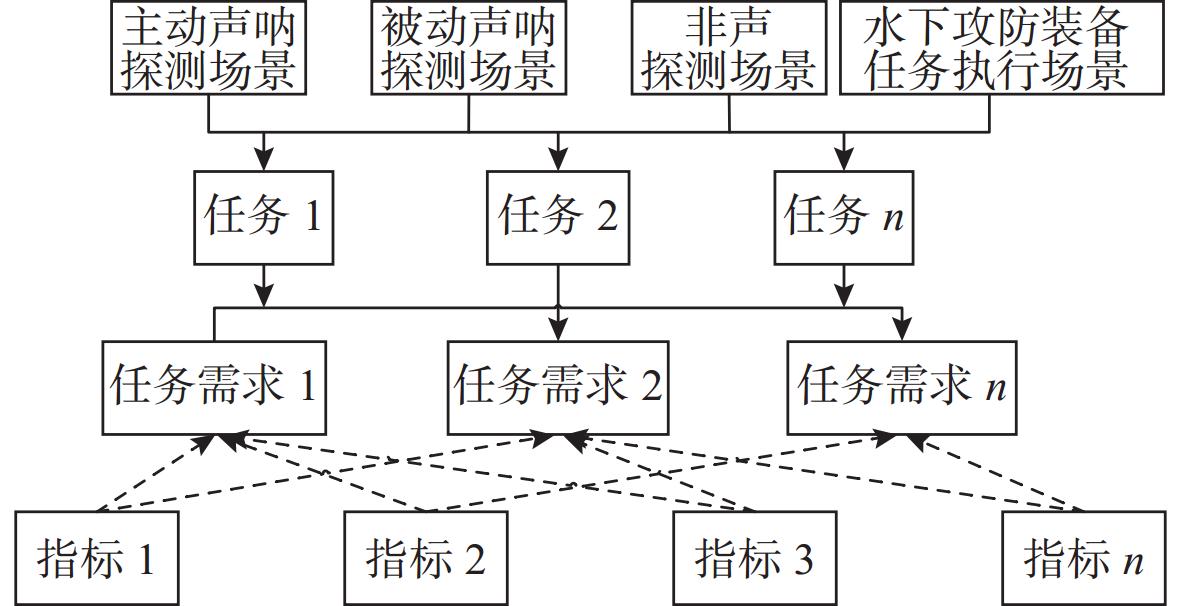Optimization of the Mission Effectiveness Evaluation Indicator System for Underwater Equipment Systems
-
摘要: 针对水下装备体系复杂度高、任务阶段性强以及战场环境动态多变导致的效能评估问题, 文中提出一种层次化的效能评估方法。通过构建面向多场景的指标归一化模型, 建立了“场景-指标-权重”的动态映射机制, 结合极大不相关准则精简冗余指标, 并基于简单几何计算和离差最大化组合赋权法实现权重优化。实验结果表明, 该方法在保证评估合理准确的同时能够显著提升计算效率, 为复杂任务环境下水下装备的体系优化与任务部署提供数据驱动的决策支持, 具有一定工程参考价值。Abstract: In view of the effectiveness evaluation problems caused by the high complexity of the underwater equipment system, the strong stage characteristics of tasks, and the dynamically changing battlefield environment, this paper proposed a hierarchical effectiveness evaluation method. By constructing an indicator normalization model for multiple scenarios, a dynamic mapping mechanism of “scenario, indicator, and weight” was established. Redundant indicator were streamlined by combining with the maximum uncorrelated criterion, and the optimization of weights was achieved based on simple geometric calculations and the combination weighting method of maximizing the deviation. Experiments show that this method not only ensures the reasonable and accurate evaluation but also significantly improves the calculation efficiency. It provides data-driven decision support for the system optimization and operational deployment of underwater equipment in mission environments and has reference value.
-
Key words:
- underwater equipment /
- effectiveness evaluation /
- indicator system /
- normalization model
-
表 1 初始效能指标体系
Table 1. Initial effectiveness indicator system
类别 指标名称 类型 范围 探测效能 协同探测面积/km2 效益型 100~500 探测次数/次 效益型 5~20 协同探测时间/min 成本型 10~30 攻防效能 有效防御扇面/(°) 效益型 50~180 兵力出动响应时间/h 成本型 0.5~2 防御队形展开时间/h 成本型 0.2~1 指挥控制 情报共享延时/s 成本型 1~5 情报有效率/% 效益型 50~100 有效指挥协同次数/次 效益型 10~50 表 2 水下装备样本指标实际值
Table 2. Actual values of sample indicators for underwater equipment
指标名称 样1 样2 样3 样4 样5 样6 样7 样8 样9 样10 样11 样12 协同探测面积/km2 120 300 480 200 450 550 180 400 250 380 500 320 探测次数/次 6 15 20 8 18 25 7 12 10 14 22 19 协同探测时间/min 35 15 12 25 10 5 28 18 22 8 14 20 有效防御扇面/(°) 50 170 150 60 180 200 80 140 90 160 190 110 兵力出动响应时间/h 2.0 0.6 1.0 1.8 0.5 0.3 1.5 0.8 1.2 0.7 0.4 0.9 防御队形展开时间/h 1.0 0.3 0.5 0.9 0.2 0.1 0.8 0.4 0.6 0.3 0.2 0.7 情报共享延时/s 5.0 2.0 1.5 4.0 1.0 0.5 3.5 2.5 3.0 1.8 0.8 2.2 情报有效率/% 50 85 75 60 95 100 65 80 70 90 98 78 有效指挥协同次数/次 10 40 30 15 50 55 20 35 25 45 48 38 表 3 样本数据指标规范化结果
Table 3. Standardized results of sample data indicators
指标名称 样1 样2 样3 样4 样5 样6 样7 样8 样9 样10 样11 样12 协同探测面积/km2 0.05 0.50 0.95 0.25 0.88 1.00 0.20 0.75 0.38 0.70 1.00 0.55 探测次数/次 0.07 0.67 1.00 0.20 0.87 1.00 0.13 0.47 0.33 0.60 1.00 0.93 协同探测时间/min 0.00 0.75 0.90 0.25 1.00 1.00 0.10 0.60 0.40 1.00 0.80 0.50 有效防御扇面/(°) 0.00 0.92 0.77 0.08 1.00 1.00 0.23 0.69 0.31 0.85 1.00 0.46 兵力出动响应时间/h 0.00 0.93 0.67 0.13 1.00 1.00 0.33 0.80 0.53 0.87 1.00 0.73 防御队形展开时间/h 0.00 0.88 0.63 0.13 1.00 1.00 0.25 0.75 0.50 0.88 1.00 0.38 情报共享延时/s 0.00 0.75 0.88 0.25 1.00 1.00 0.38 0.63 0.50 0.80 1.00 0.70 情报有效率/% 0.00 0.70 0.50 0.20 0.90 1.00 0.30 0.60 0.40 0.80 0.96 0.56 有效指挥协同次数/次 0.00 0.75 0.50 0.13 1.00 1.00 0.25 0.63 0.38 0.88 0.95 0.70 表 4 各指标同其余指标的复相关系数
Table 4. Multiple correlation coefficient between each indicator and the others
指标名称 $ {R}_{i}^{2} $ 处理结果 协同探测面积 0.75 保留 探测次数 0.65 保留 有效防御扇面 0.72 保留 情报有效率 0.68 保留 有效指挥协同次数 0.70 保留 协同探测时间 0.85 剔除 兵力出动响应时间 0.82 剔除 防御队形展开时间 0.79 保留 情报共享延时 0.81 剔除 表 5 各指标变异系数
Table 5. Coefficient of variation for each indicator
指标名称 μ σ v 协同探测面积 0.60 0.33 0.55 探测次数 0.60 0.35 0.58 有效防御扇面 0.62 0.29 0.47 情报有效率 0.56 0.28 0.50 有效指挥协同次数 0.59 0.30 0.51 防御队形展开时间 0.61 0.39 0.64 表 6 单一权重和综合权重值
Table 6. Values of single weight and comprehensive weight
指标名称 单一权重值 综合权重 算数平均法 几何平均法 特征值法 协同探测面积 0.17 0.18 0.19 0.18 探测次数 0.18 0.19 0.20 0.19 有效防御扇面 0.14 0.13 0.12 0.13 防御队形展开时间 0.21 0.22 0.23 0.22 情报有效率 0.16 0.16 0.16 0.16 有效指挥协同次数 0.14 0.12 0.10 0.12 表 7 具体任务效能评估输入数据
Table 7. The effectiveness of evaluation input data for specific tasks
指标名称 实际值 规范化值 协同探测面积/km² 380 0.70 探测次数/次 14 0.60 有效防御扇面/(°) 160 0.13 情报有效率/% 90 0.80 有效指挥协同次数/次 45 0.88 防御队形展开时间/h 0.3 0.88 -
[1] 张效天. 武器装备作战效能评估研究现状分析[J]. 科技与创新, 2024(11): 157-159, 163.ZHANG X T. Analysis of research status on operational effectiveness evaluation of weaponry and equipment[J]. Science and Innovation, 2024(11): 157-159, 163. [2] 李小波, 王维平, 王涛, 等. 装备体系贡献率评估: 理论、方法与应用[M]. 北京: 电子工业出版社, 2023. [3] 周玉臣, 林圣琳, 马萍, 等. 武器装备效能评估研究进展[J]. 系统仿真学报, 2020, 32(8): 1413-1424.ZHOU Y C, LIN S L, MA P, et al. Research progress on effectiveness evaluation of weaponry and equipment[J]. Journal of System Simulation, 2020, 32(8): 1413-1424. [4] 廖闯, 李晓莉, 陈潇楠, 等. 装备体系效能评估研究进展[J]. 舰船电子工程, 2023, 43(12): 10-13.LIAO C, LI X L, CHEN X N, et al. Research progress on effectiveness evaluation of equipment system[J]. Ship Electronic Engineering, 2023, 43(12): 10-13. [5] 张国辉, 高昂, 张雅楠. 基于RLoMAG+EAS的同构集群装备体系作战效能评估方法[J]. 系统仿真学报, 2024, 36(1): 160-169.ZHANG G H, GAO A, ZHANG Y N. Operational effectiveness evaluation method for homogeneous cluster equipment system based on RLoMAG+EAS[J]. Journal of System Simulation, 2024, 36(1): 160-169. [6] 赵海燕, 周峰, 杨文静, 等. 基于IPSO-SVR的反导装备体系效能评估方法研究[J]. 空军工程大学学报, 2024, 25(5): 82-89.ZHAO H Y, ZHOU F, YANG W J, et al. Research on effectiveness evaluation method of anti-missile equipment system based on IPSO-SVR[J]. Journal of Air Force Engineering University, 2024, 25(5): 82-89. [7] 张凯. 海战场环境下反舰导弹效能评估方法研究[J]. 舰船电子工程, 2024, 44(6): 133-136.ZHANG K. Research on effectiveness evaluation method of anti-ship missiles in maritime battlefield environment[J]. Ship Electronic Engineering, 2024, 44(6): 133-136. [8] 刘帅, 郭英, 张宏江, 等. 一种装备体系组分系统作战效能评估方法[J]. 装甲兵学报, 2022, 1(2): 50-57.LIU S, GUO Y, ZHANG H J, et al. A combat effectiveness evaluation method for component systems of equipment system[J]. Journal of Armored Forces, 2022, 1(2): 50-57. [9] 杜易洋, 李彦庆, 史文强. 美国航母编队反潜作战效能评估方法研究[J]. 舰船科学技术, 2015, 37(10): 165-169.DU Y Y, LI Y Q , SHI W Q. Research on effectiveness evaluation method of anti-submarine warfare for U. S. aircraft carrier formations[J]. Ship Science and Technology, 2015, 37(10): 165-169. [10] 葛萌萌. 一种基于凸优化的装备能力指标权重赋值方法[J]. 电讯技术, 2024, 64(4): 632-636.GE M M. A weight assignment method for equipment capability indicators based on convex optimization[J]. Telecommunications Technology, 2024, 64(4): 632-636. [11] 熊鹏俊, 刘智, 张昊, 等. 水下攻防作战体系研究[J]. 舰船科学技术, 2016, 38(19): 145-149.XIONG P J, LIU Z, ZHANG H, et al. Research on underwater offensive and defensive combat system[J]. Ship Science and Technology, 2016, 38(19): 145-149. [12] 李正阳, 于旭东, 周全. 水下自主导航装备作战效能评估技术[J]. 舰船电子工程, 2021, 41(7): 156-159, 182.LI Z Y, YU X D, ZHOU Q. Combat effectiveness evaluation technology for underwater autonomous navigation equipment[J]. Ship Electronic Engineering, 2021, 41(7): 156-159, 182. [13] 顾云涛, 李斌, 李彦. “水下域”作战仿真技术在提高水下作战效能中的应用[J]. 现代导航, 2022, 13(2): 153-156.GU Y T, LI B, LI Y. Application of "underwater domain" combat simulation technology in improving underwater operational effectiveness[J]. Modern Navigation, 2022, 13(2): 153-156. [14] 班明莉. 基于场景分析的重大传染病疫情现场防控装备优化配置及效能评估[D]. 北京: 军事科学院, 2022. [15] 宗飞, 王洋洋, 王博, 等. 多阶段任务装备体系作战效能评估及灵敏度分析[J]. 兵器装备工程学报, 2024, 45(8): 87-94. doi: 10.11809/bqzbgcxb2024.08.012ZONG F, WANG Y Y, WANG B, et al. Operational effectiveness evaluation and sensitivity analysis of multi-phase mission equipment system[J]. Journal of Ordnance Equipment Engineering, 2024, 45(8): 87-94. doi: 10.11809/bqzbgcxb2024.08.012 [16] 秦茂森, 赵丹玲, 杨克巍. 基于作战网络的反潜活动效能评估[J]. 系统工程与电子技术, 2018, 40(7): 1513-1520.QIN M S, ZHAO D L, YANG K W. Effectiveness evaluation of anti-submarine activities based on combat network[J]. Systems Engineering and Electronics, 2018, 40(7): 1513-1520. [17] 周雨婷, 叶国菊, 刘尉, 等. 基于组合赋权的直觉模糊多属性动态决策方法[J]. 西华大学学报(自然科学版), 2022, 41(1): 90-95. [18] 林娟运, 郑为法, 罗丹娜. 基于离差最大化-TOPSIS模型的城市创新竞争力综合评价——以广东省21个地市为例[J]. 科技和产业, 2024, 24(15): 68-72. [19] GUNST R F, WEBSTER J T. Regression analysis and problems of multicollinearity[J]. Communications in Statistics, 2007, 4(3): 277-292. [20] ETAGA H O, NDUBISI R C, OLUEBUBE N L. Effect of multicollinearity on variable selection in multiple regression[J]. Science Journal of Applied Mathematics and Statistics, 2021, 9(6): 153. -





 下载:
下载:







